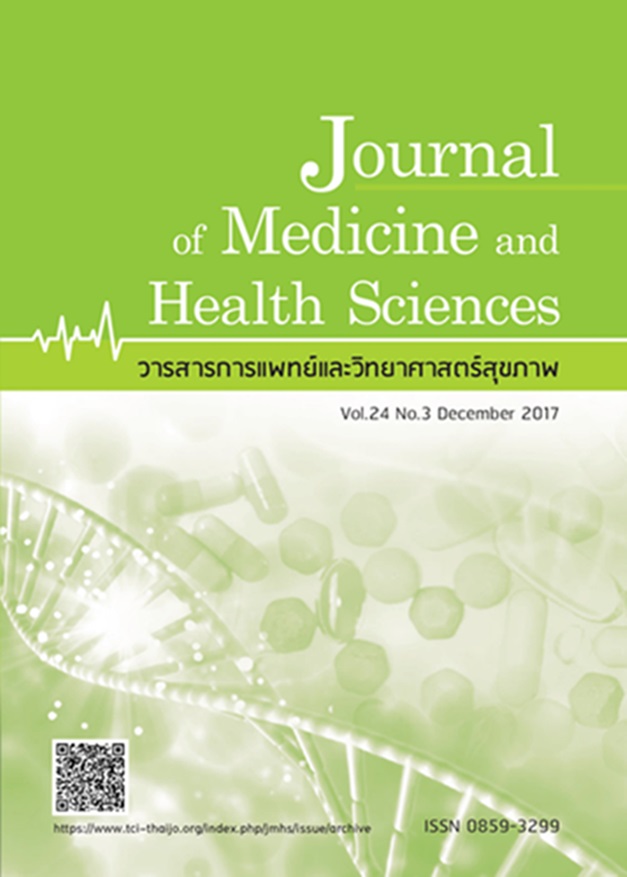การวิเคราะห์พื้นที่เสี่ยงการเกิดไข้เลือดออกด้วยระบบสารสนเทศภูมิศาสตร์ ตำบลโดมประดิษฐ์ อำเภอน้ำยืน จังหวัดอุบลราชธาน
Keywords:
พื้นที่เสี่ยง, โรคไข้เลือดออก, การวิเคราะห์เชิงลำดับชั้น, ระบบสารสนเทศภูมิศาสตร์, dengue fever, risk area, analytical hierarchy process, geographical information systemsAbstract
ไข้เลือดออกเป็นปัญหาสำคัญด้านสุขภาพ ระบาดในประเทศไทยมาเป็นเวลานาน จึงต้องหาทาง ป้องกันการเกิดโรค การวิจัยครั้งนี้มีจุดประสงค์เพื่อสำรวจต่ำแหน่งผู้ป่วยและวิเคราะห์พื้นที่เสี่ยงต่อการเกิด ไข้เลือดออก ได้รวบรวมข้อมูลผู้ป่วยปี 2556-2558 ทั้งหมด 60 ราย เก็บข้อมูลตำแหน่งที่อยู่ผู้ป่วยด้วยเครื่องระบุ ตำแหน่งบนโลก และวิเคราะห์พื้นที่เสี่ยงด้วยกระบวนการวิเคราะห์เชิงลำดับชั้น (AHP) ร่วมกับระบบสารสนเทศ ภูมิศาสตร์ด้วยการซ้อนทับข้อมูล พบว่า ปี 2556 มีจำนวนผู้ป่วยมากที่สุดที่ หมู่บ้านโนนสูง ปี 2557 พบมาก ที่สุดที่หมู่บ้านโนนสูง และปี 2558 พบมากที่สุดที่ หมู่บ้านจันลา การจัดลำดับปัจจัยที่สำคัญมากที่สุดคือ ความ หนาแน่นผู้ป่วย รองลงมาคือ ค่าดัชนีลูกน้ำยุงลาย ความหนาแน่นครัวเรือน ความหนาแน่นประชากร และการ ใช้ที่ดิน คิดเป็นร้อยละ 39, 35, 13, 7 และ 4 ตามลำดับ การวิเคราะห์พื้นที่เสี่ยงสามารถแบ่งเป็น 5 ระดับ คือ เสี่ยงมากที่สุด พบมากบริเวณพื้นที่ความหนาแน่นผู้ป่วยสูงและหมู่บ้านที่ครัวเรือนหนาแน่นสูง เสี่ยงมาก พบมากพื้นที่ความหนาแน่นหลังคาเรือนสูง เสี่ยงปานกลาง พบในหมู่บ้านที่มีประชากรหนาแน่นน้อยและ ความหนาแน่นครัวเรือนต่ำ เสี่ยงน้อย พบหมู่บ้านที่มีประชากรหนาแน่นน้อยสุดและค่าดัชนีลูกน้ำยุงลายต่ำ และเสี่ยงน้อยที่สุด พบบริเวณพื้นที่ป่าเนื่องจากยุงลายส่วนใหญ่เพาะพันธุ์ในพื้นที่ชุมชน พื้นที่เกษตรกรรม พื้นที่เสี่ยงมากที่สุด พบบริเวณหมู่บ้านจันลา ท่าแสนคูณ และนาหนองหว้า ตามลำดับ ดังนั้น หน่วยงานที่ เกี่ยวข้องสามารถนำแผนที่ไปใช้ในการวางแผนและป้องกันโรคไข้เลือดออกได้
For a long time outbreaks of Dengue Haemorrahagic have been a major health problem in Thailand and ways need to be found to prevent this disease. The purpose of this research is to survey the patients and to analyze areas at risk of dengue. There were 60 patients recorded as having Dengue Haemorragic fever between 2013-2015, their locations were found by using Global Positioning System (GPS). The risk areas were established by Analysis Hierarchy Process (AHP) with Geographic Information Systems (GIS) to overlay spatial data analysis. The results showed that in 2013-2014, the number of patients was the highest at Non Sung village and in 2015 it was most commonly found in Chan village. The ranking of the important factors was determined by the density of patients, followed by mosquito larval index, household density and land use 39%, 35%, 13%, 7% and 4%, respectively. The analysis showed that there were 5 levels of risk 1) The ‘riskiest level’ was found in high density areas and high-density households, 2) The ‘most risk level’ was found in high-density households, 3) The ‘moderate risk level’ was found in villages with a low density population and low density households, 4) The ‘low risk level’ was found in villages with the lowest density of population and low mosquito larvae, and 5) The ‘minimal risk level’ was found in the forest area. The results illustrated that the mosquitoes were breeding in the community and agricultural areas, particularly the three villages of Chanla, Tha Saenkuon and Na Nong Wa, respectively. Therefore, the local government are eager to use the GIS map to make a plan for the protection of the people who live in the affected communities.
References
severe dengue. 2016 [cited 2017 4 June];
Available from: http://www.who.int/
mediacentre/factsheets/fs117/en/
2. World health organization. The dengue
situation or its surveillance. 2016 [cited
2017 7 June]; Available from: http://
www.wpro.who.int/emerging_diseases/
DengueSituationUpdates/en/
3. Ministry of Public Health. Strategy
Indications and Storage guidelines.
2016 [cited 2017 28 May]; Available
from: http://region5.moph.go.th/docs/
mophplan_2559_final.pdf
4. Prabphala S. Using geographic information
system to identify environmental factors
for risk area of dengue hemorrhagic fever
infection: A case study in Chaiyaphum
province. J Remote Sensing GIS Assoc
Thai 2008;9(3):24-34.
5. Ubon Ratchathani provincial health
office. Situation of community health,
Nam Yuen district, Ubon Ratchathani
province 2016.
6. Dengting S. Application of geographic
information system on studying an
epidemic of dengue hemorrhagicfever
in Bongtun Subdistrict, Doi Tao District,
Chiang Mai province. M.S. Thesis. Chiang
Mai; Department of Public health, Chiang
Mai university 2009.
7. Desaster prevention and mitigation.
Criteria to evaluate mosquito larvae
index, Srisaket province 2015.
8. Chinanonwech N. Bureau of Insect
Infestation, Department of Disease
Control, Ministry of Public Health 2013.
9. Huisman O, De By RA. Principles of
geographic information systems. ITC
Educational Textbook Series. 2009;1.
10. Lai PC, So FM, Chan KW. Spatial
epidemiological approaches in disease
mapping and analysis. CRC press; 2008
Aug 18.
11. Dom NC, Ahmad AH, Latif ZA, et al.
Application of geographical information
system-based analytical hierarchy
process as a tool for dengue risk
assessment. Asian Pac J Trop Dis. 2016;
6(12):928-35.
12. Ponpetch K. Geographic information
system for prevention and control
planning of dengue haemorrhangic fever
in Phetchaburi province. [M.S. Thesis].
Bangkok; Department of Environmental
Science, Silpakorn university 2008.
13. Gomes LF, Andrade RM. Performance
evaluation in assets management with
the AHP. Pesquisa Operational 2012;
32(1):31-54.
14. Jeefoo P. Dengue risk zone index (DRZI)
for mapping dengue risk areas. Int J
Health Geogr 2011;7(1).
15. Saengnill W, Wongbutdee J. Application
of a geographic information system for
risk area classification of Malaria incidence
in Thai-Laos-Cambodia borderlands,
Sisaket and Ubon Ratchathani province.
J Public Health 2014;44(3):260-72.
16. Saengnill W, Wongbutdee J. Aedes aegypti
larval prevalence vector and prevention
behavior for Dengue Haemorrhagic
fever in risk area case study: Na Non
Noi, Warinchamrab, Ubon Ratchathani
Province. Conference; Rethink: Social
Development for Sustainability in ASEAN
Community in 16-19 February 2014;840-45.
17. Bureau of Epidemiology, Department of
Disease Control Ministry of Public Health,
Thailand, Conclusion of Monitoring
System on Five Diseases, year of 2016.
2016 [cited 2017 26 September];
Available from: https://www.m-society.
go.th/ewt_news.php?nid=19337
18. World health organization. Key Issues
in dengue vector control toward the
operationalization of a global strategy.
1995 [cited 2017 26 September];
Available from: https://books.google.
co.th/books/about/Report_of_the_
Consultation_on_Key_Issues.html?id=VOSYgEACAAJ&redir_esc=y
19. Chien LC, Yu HL. Impact of meteorological
factors on the spatiotemporal patterns
of dengue fever incidence. Environ Int
2014;73:46-56.



